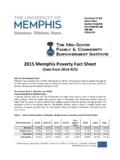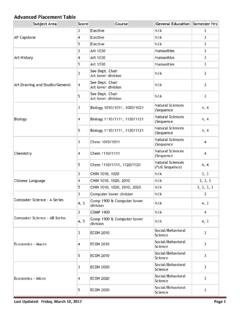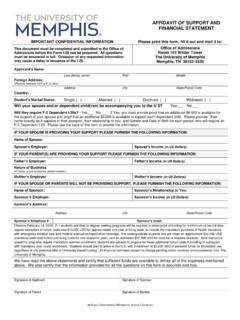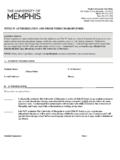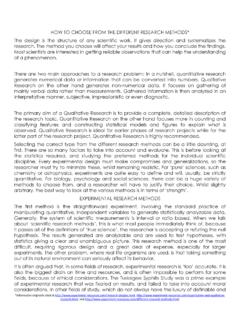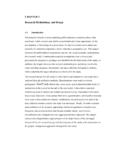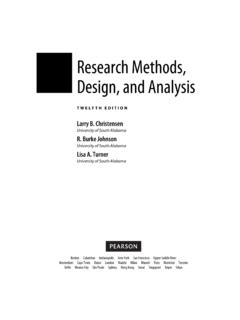Transcription of RESEARCH DESIGN COMPREHENSIVE EXAM …
1 1 RESEARCH DESIGN COMPREHENSIVE EXAM question Your Charge: You are charged with designing the methodology for a RESEARCH study. This study CAN be your dissertation. This is essentially a complete, fully justified chapter three of the dissertation proposal. Provide details, explain your choices, and justify each decision. An outline for a quantitative study or qualitative study appears below. Follow it! Chapter Three: Methodology Quantitative Study RESEARCH DESIGN This is a relatively simple, two or five-sentence paragraph indicating the type of RESEARCH study you are going to do ( , experimental, survey, pre- and post-test of achievement, qualitative interviews, etc., etc.) and justifying your choice. It is good to refer to RESEARCH guides, traditions, or experts for your type of study; this helps your reader place your methodology in the context of the guidance provided by experts. Population and Sample Describe the population you wish to study; identify your sampling technique; justify your sampling technique in terms of its ability to get you a useful and valid sample.
2 Discuss limitations of sample, if any. Address IRB issues; how you will protect human rights, ensure anonymity, and gain consent. RESEARCH Questions and Hypotheses Provide your RESEARCH questions and hypotheses for each RESEARCH question . I could see this section going before Data Collection or here. Instrument Describe the development of your instrument; how you intend to pilot-test it to ensure face validity; a draft instrument should be available in an appendix; indicate which items will be used to answer which RESEARCH questions. If your instrument has already been developed, you will want to describe the instrument, who validated it, how it has been used, RESEARCH or researchers who use it, where it is available (or how it was acquired), and it should be included in the appendix. Variables Define major variables: independent and dependent variables and their relationship to instrument.
3 Explain how they will be coded. Do this in prose, but you can add a table with this information (the table must be explained in the prose and cannot stand alone). Data Collection Explain in detail the administration of the instrument, including dates, times, how contacted, etc. How you will enter the data and treat missing data. Data Analysis For each RESEARCH question and hypothesis, how you will analyze the data, which statistic you will use (and justify this choice), what p value you intend to use and why, and what tests for normality, homoscedascity, collinearity, etc., etc. will you do? Reliability & Validity Address how you will assure these aspects of RESEARCH . What tests for collinearity, homogeneity, normal distribution, etc. will you use? 2 Final Paragraph Summarize the chapter and set up what will be covered in Chapters 4 and 5. Chapter Three: Methodology Qualitative Study RESEARCH DESIGN This is a relatively simple, two or five-sentence paragraph indicating the type of RESEARCH study you are going to do ( , qualitative RESEARCH , ethnography, phenomenology, etc.)
4 And justifying your choice. It is good to refer to RESEARCH guides, traditions, or experts for your type of study; this helps your reader place your study in the context of the guidance provided by experts. Epistemology Develop 2-3 paragraphs to discuss 1) what epistemology is in general and how it generally guides RESEARCH and 2) what epistemology is best for your study and why. Theoretical 1). Identify the qualitative RESEARCH theory that is best for your study and explain why it has been chosen. 2) Explain how theory rests upon epistemology and with which epistemology your theory is best aligned. 3) Give an overview of your theory, including underlying philosophies, key players, development, and ) Explain how this theory guides RESEARCH questions, methodology, methods , and desired uses of RESEARCH products. Methodology (3 parts) 1. Participants You need to describe your participant selection technique, and justify why you need these individuals to answer your RESEARCH questions.
5 Address IRB issues; how you will protect human rights, ensure anonymity or confidentiality, and gain consent. 2. Data Collection 1. Address sources of data (for triangulation, if required). 2. Describe the steps, in order, of your three types of data collection. This is a how to manual for someone who might want to repeat your study; think of it as a cookbook or directions for assembling a bookshelf. Put a sub-header for each type of data such as Participant Interviews Documents Researcher Notes and give the steps. 3. Reliability You must address reliability issues: this is done usually through member checking, peer debriefing, checking your decisions, etc. Use your guide as a key to this process. Data Analysis Describe, in detail, how you will a) identify, classify, code or label, and b) order or combine your themes; c) how you will verify or triangulate themes or other findings; d) how you will handle inconsistencies; e) how you will create your theory (if ethnography).
6 Be very detailed. Have a plan. Subjectivities Identify the researcher s preconceptions or biases and how these will be addressed during data collection or analysis. 3 Final Paragraph Summarize the chapter and set up what will be covered in Chapters 4 and 5. Evaluation Criteria Page count: There is no specific page count for this question ; all items must be described and justified in depth. Completeness 90% Accuracy (writing, APA) 10% Evaluation Scoring Exceeds Expectations: 90-100 points Meets Expectations: 80-89 points Fails to Meet Expectations: 0-79 points

